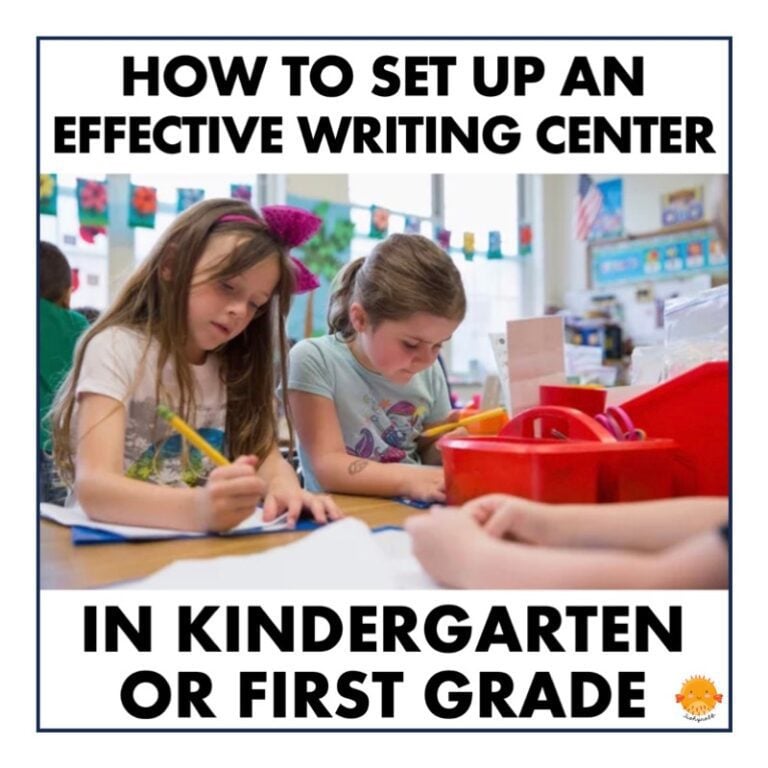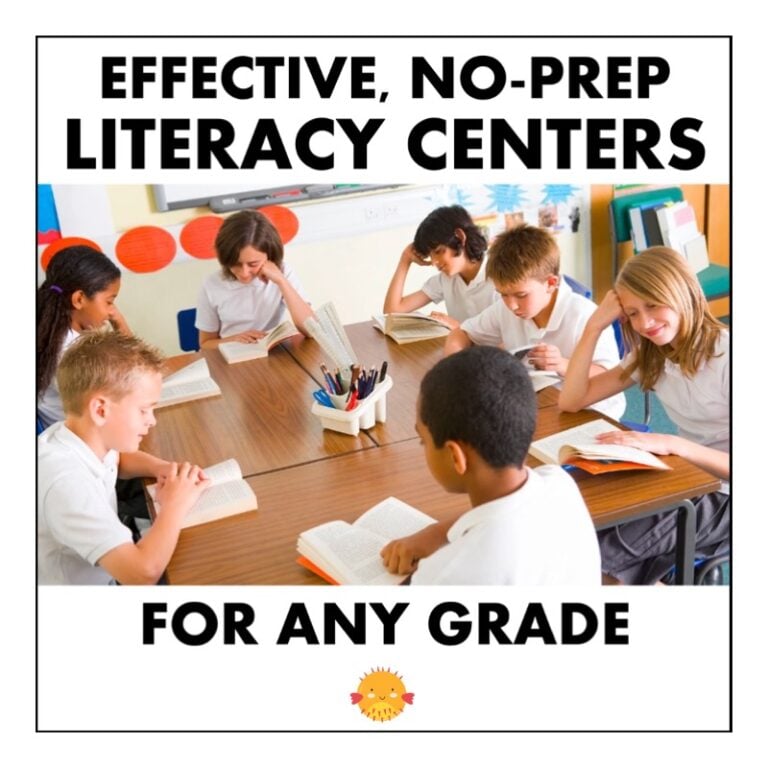
5 Fact and Opinion Activities & Lesson Ideas Your Students Will Love
Understanding the difference between fact and opinion is a skill often taught in the first and second grades. It is usually part of reading instruction, but this is actually a very important life skill. Imagine being an adult and trying to get through life without it.
Today, we’ll explore some engaging fact and opinion activities and lessons for second to third grade.

Why is it important to teach fact and opinion?
Someone who can’t tell the difference between a fact and an opinion can quickly be taken advantage of. They are unable to determine what is believable and accurate and what isn’t. Making good decisions becomes impossible if you don’t know what are factual statements and what is simply someone else’s personal belief.
Imagine being a salesman or politician and encountering someone who doesn’t know the difference? Talk about a dream come true!
Aside from getting by in life, students need a solid grasp of fact and opinion to be successful at writing. Persuasive writing involves opinion statements supported by facts. Expository writing should educate and inform without any opinions at all.
What about reading? Understanding fact and opinion is an essential skill that helps students filter through information and recognize reliable sources vs. what is simply the author’s perspective.
.
Fun Fact and Opinion Activities for the Classroom
Teaching fact and opinion to elementary students can be tricky. It is often really hard to convince young children that what they think isn’t necessarily a fact – or that someone else can have a different opinion and still be right. It’s a critical thinking skill that takes time to develop.
I have found that the best way to teach fact and opinion is with a variety of activities that let students practice in many different ways and contexts. A simple fact and opinion sort just won’t do the trick by itself. Here are some of the activities I use to teach this skill that you can work into your lesson plan:
.
The Most Amazing Teacher in the World
I start teaching fact and opinion with an opinion mini lesson that the kids always love. First, I collect a few props like a paper crown, a small mirror, and a dictionary. While the whole group is busy working on something, I walk to the back of the room and quietly grab all the props. Then I strut proudly to the front of the room with my gear.
What happens next is always the same… the kids go nuts. They start laughing and pointing and wondering what on earth is wrong with their crazy teacher. That’s when I start my act and introduce them to some opinion-based statements:
- “What is wrong with all of you? Why are you laughing? Can’t you see I am the most amazing teacher in the world? I am so awesome that you can call me the Queen of Teaching from now on. Look at my crown!”
- “Oh no? I’m not the best, most amazing teacher ever? Well I am the most beautiful person in this school! I mean look at me… I’m perfect! I can see myself right here in this mirror. I am so gorgeous!”
- “I don’t know why you all don’t believe me! I know what I’m talking about. In fact, I know almost everything because I am so smart, like a genius. See this dictionary here? I’m even smarter than the person who wrote this book!”
.
By now, the class has lost their minds over my absurd behavior and ridiculous statements. After they all settle down, we have a nice chat about what opinions are. I get out some sticky notes and we make a chart of all the things I said that were definitely not facts. Then, they go straight home and explain it all to their parents. It’s a very effective way to introduce opinion.
.
Opinion Word Search
Now that they can all recognize obvious opinion statements, it time for students to apply that knowledge to text. I start our next activity by writing a few opinion sentences on some chart paper. I might write:
- This is a delicious piece of cake!
- I saw a beautiful giraffe at the zoo yesterday.
- The Grand Canyon is the best place to take a vacation.
- Roller coasters are scary but fun.
- My younger brother is really annoying.
- Guinea pigs are furry and adorable animals.
.
Next, we dissect each sentence searching for the clue words that tell us something is an opinion. When they find an opinion word, I have someone underline it with a colored marker. Once we all agree on what makes each of my sentences an opinion, we make an anchor chart with a list of all the opinion key words we found.
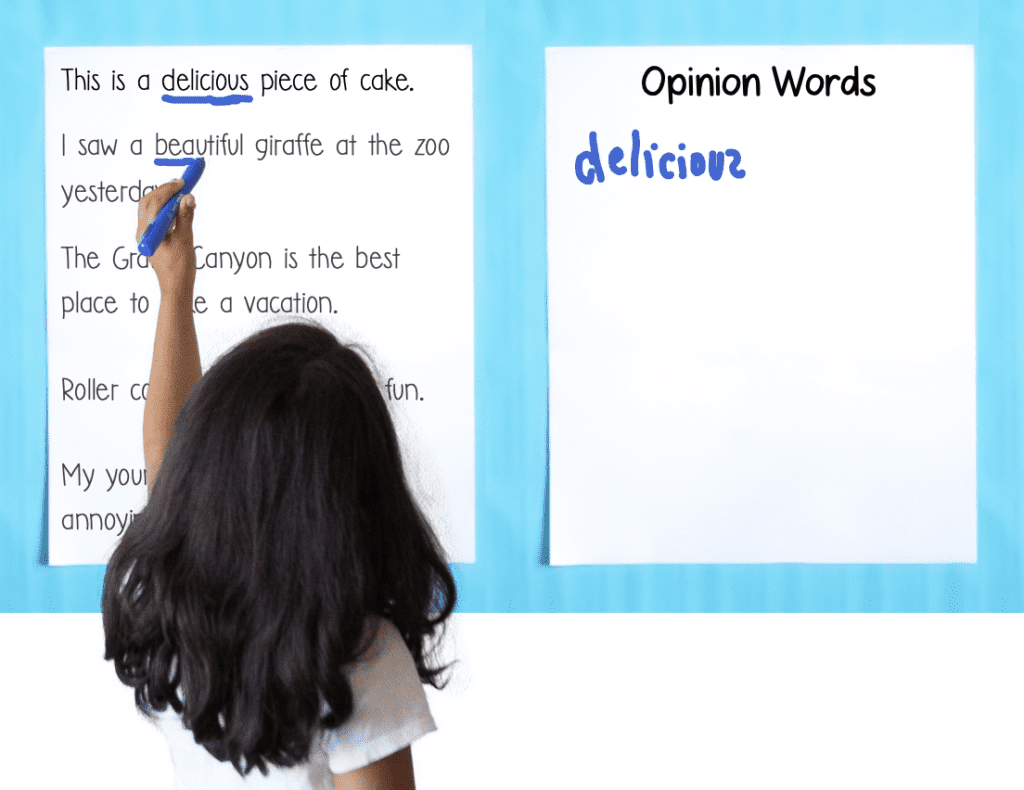
.
This activity can be done as a whole group lesson, but I prefer to do it in small groups. That lets me really see who gets it and who doesn’t and better support the kids who need it. I can also use simpler sentences with my lower-level readers.
.
Sentence Wizards
The next step in teaching fact and opinion is to get students to transform opinions into factual statements. This also requires them to recognize which words indicate when something is an opinion. For this activity, I write opinion sentences on index cards and place them around the room. Then I divide the class up into several groups.
Each group gets a set of sentence strips. They put on their wizard thinking caps and work together to change each of my opinion cards into a fact. The goal is to use as many of my words as possible to create their own fact statement.
Here is what it looks like:
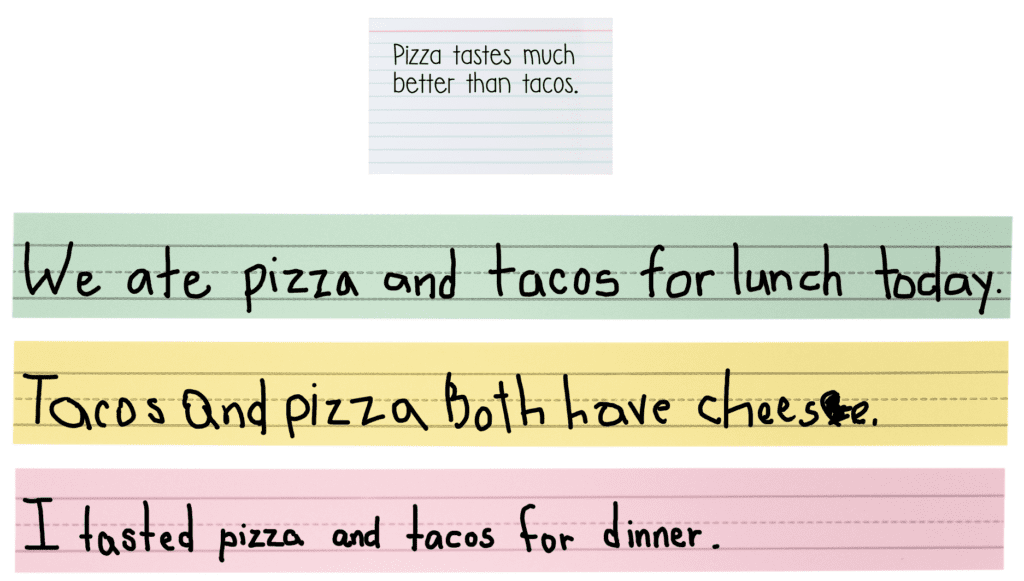
.
They were all successful at taking out the opinion words and rewriting the sentences with just factual statements about pizza and tacos.
.
Fact and Opinion Detectives
Finally, it’s time for some real text detective fun by letting students investigate a few crimes with their newfound skills. This is called “Just the Facts, Ma’am” and it’s always one of my students’ favorite fact and opinion activities of the year!
I start by putting together the case files which include a short description of the crime and four witness statements.
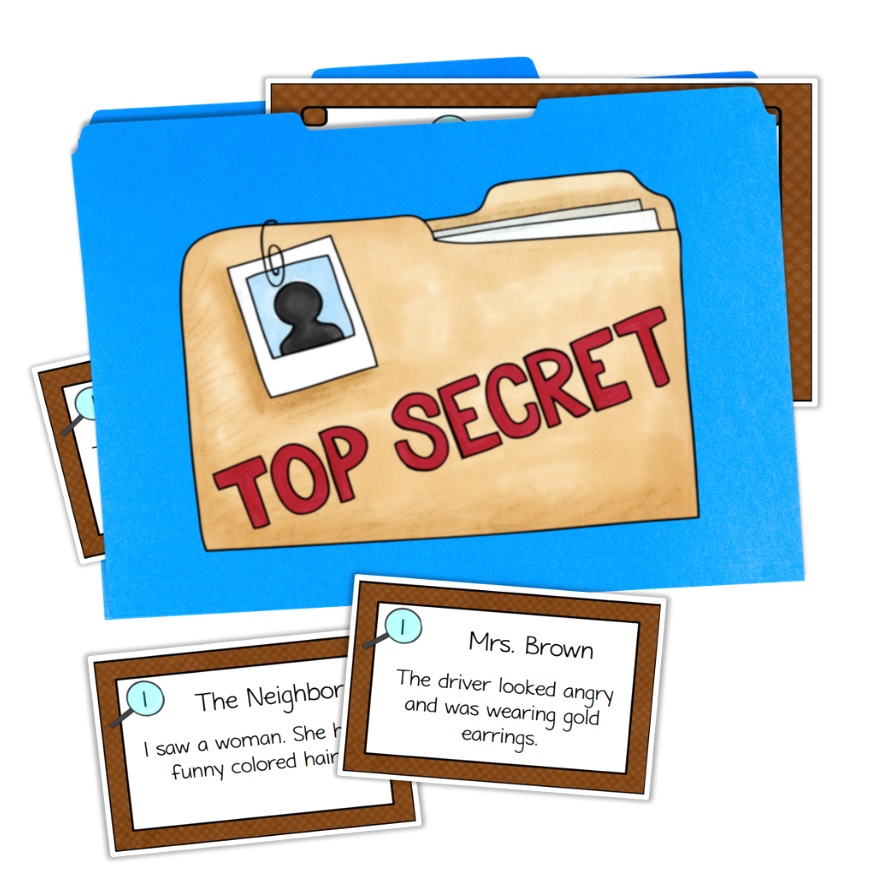
.
The “text detectives” must read through the file, record the facts of the case in their detective notebooks, and then use that information to find the culprit. The trick is to weed through what the witnesses said and disregard the parts that are just opinions.
I usually present the first case to the whole class and we work to solve it together. Once they have a hang of what to do, I split them into groups to rotate through the different cases. This is always a very fun activity and the kids LOVE being text detectives.
.
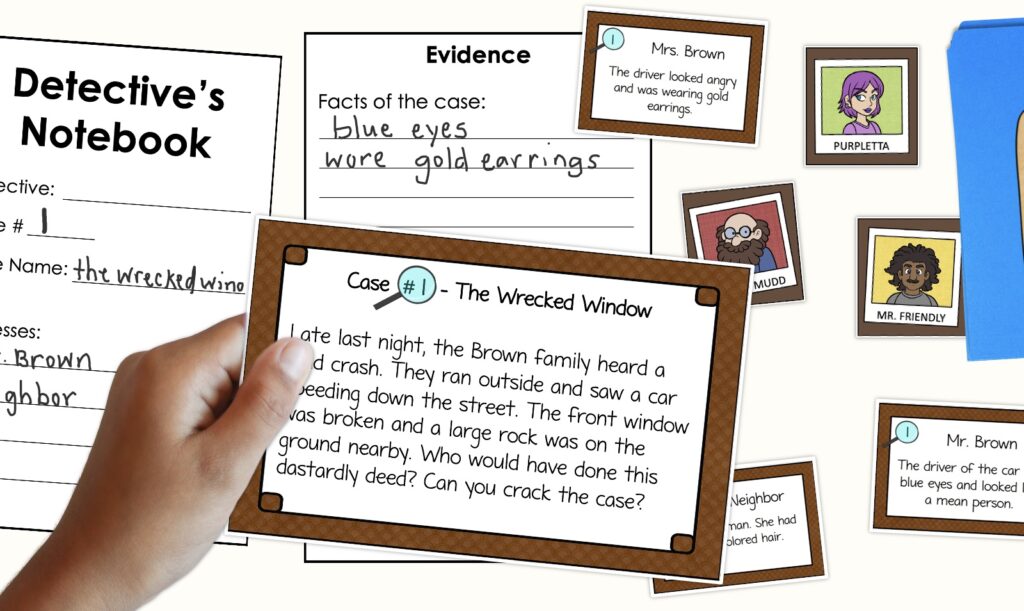
.
Fact and Opinion Mentor Texts
Besides these hands-on activities, there are also some good mentor texts for teaching fact and opinion. Here are a few of my favorites:
- I Wanna Iguana by Karen Orloff
- My Rotten Redheaded Older Brother by Patricia Polacco
- Finding Winnie by Lindsay Mattick
.
For a description of how to use Finding Winnie to teach fact and opinion and a fantastic resource to go along with it, check out this blog post from Comprehension Connection: Teaching Fact and Opinion with Finding Winnie in Just 4 Steps
I also make sure to read a few nonfiction books to my students so they can see the difference in how the topics are presented. For example, after reading the book I Wanna Iguana, I would follow up with Amazing Animals: Iguanas.
While reading each book, we use graphic organizers to keep track of all the opinions and facts we find by listing them in the appropriate columns.
After all of these fact and opinion activities and lessons, students usually have a pretty good understanding and are ready to tackle opinion writing which is always really fun!
.
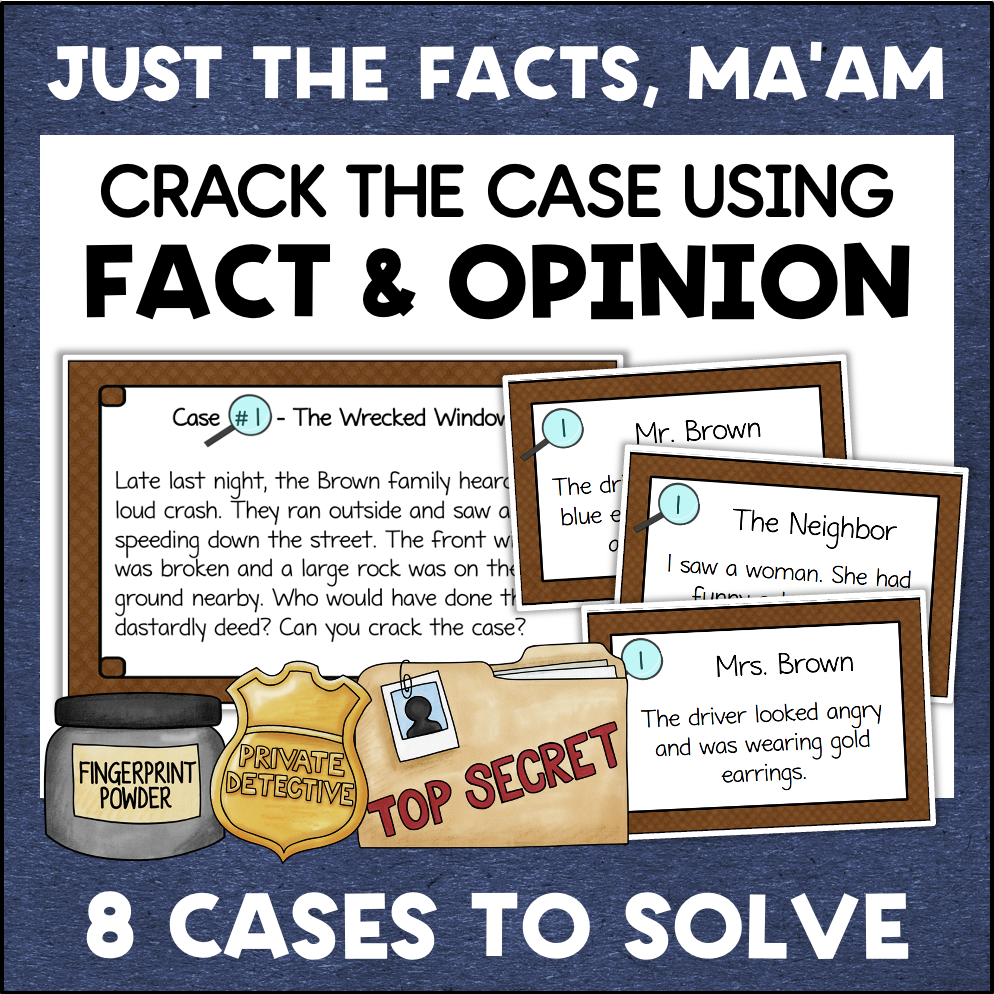
The resource highlighted in this blog post is Just The Facts, Ma’am: Crack the Case Using Fact & Opinion
These fact and opinion activities include 8 different cases to solve along with case files, storylines, witness statements, suspect cards, and a detective notebook.
There is also separate a fact and opinion sorting activity.

